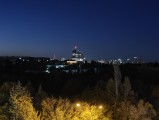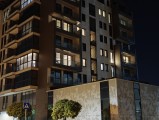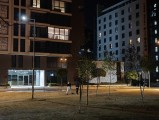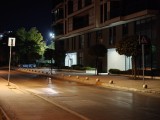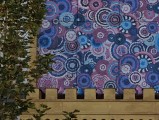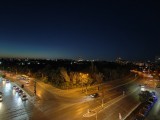OnePlus Open review

Three high-end shooters on the back, two selfie cameras
The OnePlus Open has three major cameras on its back - a 48MP primary, a 48MP ultrawide/macro, and a 64MP telephoto camera with 3x optical and up to 6x in-sensor magnification.
There are two selfie cameras in dedicated punch holes on both screens - a 32MP imager inside the cover and a 20MP shooter inside the foldable display.

The primary camera on the Open uses a 52MP Sony LYT-T808 sensor, a sensor of Sony's new LYTIA lineup, which comes with the latest stacked architecture similar to Sony's current flagships - the Xperia 1 V and 5 V. In fact, according to hardware info apps, it's reported as being the same identical sensor used by the Xperias - IMX 888. It is a 52MP multi-aspect sensor that outputs 48MP effective resolution in 4:3 aspect ratio. It has 1.12µm pixels, and it sits behind a stabilized (OIS) 24mm f/1.7 lens.
The new LYTIA sensors are an upgrade over the ExmorRS sensors as they use a stacked structure. What's stacked in this case is that the photodiodes and their corresponding transistors sit on two separate layers instead of next to each other in a conventional manner. While requiring micron-level alignment accuracy, it has also meant the photodiodes are now larger, collecting light twice as well and also up to three times higher saturation levels. The transistors sitting on a separate layer have also been optimized, which has resulted in a cleaner signal with less noise.
The 4.3:3 multi-aspect sensor has a larger area than the mainstream 4:3 sensor, and this can be used to improve video stabilization.
The ultrawide camera relies on a 48MP Sony IMX581 1/2.0" sensor with 0.8µm pixels. It is coupled with a 14mm f/2.2 lens. Autofocus is available, and so is macro photography, starting from just 3.5cm away.
The telephoto camera is quite interesting. It uses a 64MP OmniVision OV64B 1/2.0" sensor with 0.7µm pixels. There is a periscope here - 70mm f/2.6 stabilized lens (OIS) - for 3x optical zoom. Furthermore, this camera supports up to 6x lossless magnification via in-sensor zoom.
The 32MP selfie camera inside the cover screen has an OmniVision OV32C 1/3.14" sensor with 0.7µm pixels and a Quad-Bayer filter. The lens is 5P 22mm f/2.4, the focus is fixed.

Finally, the inner selfie camera packs a 20MP a 1/4" sensor with 0.7µm pixels and a Quad-Bayer filter. The lens here is 4P 22mm f/2.2, and the focus is still fixed.

All rear cameras support 4K 60FPS video capturing with always-on EIS. 4K 30FPS Dolby Vision option is also available.
The selfie cameras also support 4K video recording with always-on EIS, but they are locked at 30FPS. There is no support for Dolby Vision capturing here.
Camera app
The Oppo/OnePlus-Hasselblad collaboration makes it to the OnePlus Open, and this means that the Swedish camera company has pitched in with some color science and whatnot.

The Hasselblad influence can also be more readily seen in the viewfinder of the camera app, where the accent has turned orange. Other than that, the app is not much different than what you'll find on any OnePlus, Oppo or Realme.
That is, before you get to the foldable aspects of its operation, which is where all the fun of having a OnePlus Open is. There are three small shortcuts around the upper left corner of the full-blown UI. The first one minimizes the camera viewfinder to one part of the screen, while the other half allows you to scroll, view and edit your recently shot images. This way, the camera stays ready if another cool moment worth capturing comes around.

The next one shows a preview on the cover screen - this way, your friends will see themselves while you are taking photos of them. And with the final one, you will be able to use the Cover screen as a primary viewfinder and take selfies with the rear cameras.
And before we close this chapter, we want to point out that you can use the Flex mode (the halfway opened position) for tripod purposes. If it's not windy, it's a great way to take timelapses and group photos with you in them.

Daylight photo quality
The main camera saves 12MP photos by default, and we found those to be of impressive quality. First - they are incredibly detailed, with a balanced look and just the right sharpness. Foliage, intricate and complex details, people - they are all developed very well and look natural.
There is zero noise across the photos, the contrast is high, and the colors are vivid and lively, even if a bit more saturated.
The dynamic range is enough - sometimes wide, sometimes average. Some samples look a bit over-exposed. Note that the OnePlus Open is still receiving updates, including camera ones, and this is likely to be addressed.
The OnePlus Open main camera offers high-quality 2x magnification via in-sensor zoom. This is basically a crop from the center of the 48MP output, keeping in mind the sensor's Quad-Bayer filter.
The 2x zoomed photos are quite nice - they are detailed and sharp, with likable colors, high contrast and good dynamic range. There is no visible noise.
You can see their artificial look when zoomed at 100% - especially when there is a lot of random detail like the foliage. That is because of the reverse binning process, which is mostly a complex math.
Still, while their per-pixel detail is not a match to the default photos', we still find these perfectly usable and of high quality.
And here are some 48MP photos from the main camera. As you can see, these have the same quality as the 2x zoom samples sans the crop, of course. It doesn't appear that we can squeeze more detail of the 48MP images when downscaling them to 12MP.
The telephoto camera saves stunning 3x zoomed photos. They have top-notch detail, no noise, they are not over-sharpened, and every single object looks natural and life-like. The colors are lively and punchy but not over the top; the contrast is great, and the dynamic range is adequate. Overall, these are some of the best 3x zoomed images we've come across lately.
Since the telephoto camera uses a 64MP sensor, it also offers up to 6x sort of lossless zoom via a crop from the center.
Well, the 6x samples we shot are excellent. They are a bit softer than the 3x ones, naturally, and we can spot a minor spike in the noise levels, but they still turned out a lot better than we expected them to be.
All photos offer plenty of detail, good sharpness, low noise, and the same balanced rendition as the other camera and modes. The colors are nice, the dynamic range is wide, and the contrast is good.
The 64MP 3x photos we shot with the zoom camera appear to be simply upscaled from the default output, unfortunately.
The ultrawide camera saves 12MP by default, and those are super wide and fit a lot in the frame, and yet - the corners remain sharp enough and straightened very well by the automatic distortion correction.
The photos offer enough detail, low if any noise, the same balanced rendition we saw across the other cameras, and likable color rendition. The dynamic range is average, the contrast is good, but sometimes the photos are over-exposed. As we mentioned, OnePlus is working on its algorithms so this may and will likely improve in time for the launch.
The autofocus capabilities of the ultrawide camera allow for macro shooting from as close as 3.5cm away. The closeup shots we took are thoroughly impressive - with exceptional detail, excellent sharpness, superb colors, wide dynamic range.
The 48MP ultrawide photos are quite bad; they were poorly upscaled from the 12MP output.
Portraits
The Portrait mode on the OnePlus Open offers three zoom levels - 1x, 2x and 3x. The 1x zoom should mimic the Hasselblad XCD 30mm lens - meaning a wider field of view and artistic look for the bokeh. The 2x zoom corresponds to Hasselblad CXD 65mm lens for natural half-body portraits and beautiful bokeh. Finally, the 3x zoom is like the Hasselblad XDD 90V lens with a soft background and highlighted subjects.
Whatever mode you select, if there are no light sources in your background, you won't see a big difference in the bokeh. Furthermore - you can always tweak it in each mode.
No matter which mode you use, the portraits are always outstanding - the subject is detailed and sharp, with natural skin tones, well-exposed, and with accurate colors. The bokeh is absolutely lovely and realistic. Great job, OnePlus!
Selfies
You can shoot selfies with the two front cameras (read in the screens' perforations), or you can use the rear setup with the assistance of the cover screen.
Let's start with the 32MP camera inside the cover display. It's a Quad-Bayer imager that still outputs 32MP photos, which means they are artificially upscaled.
The 32MP photos look great on the phone's screen. Their dynamic range is good, and the colors are true to life. But all the photos are a bit hazy - we don't mean lacking in contrast but lacking in definition. It appears to be a software issue, something related to the camera processing so it might get fixed down the line.
The 20MP camera inside the foldable screen produces cleaner photos, but less detailed - here the upscaling is far more evident. They do offer a wide dynamic range and punchy colors, and are noise-free.
The main camera shoots the best selfies with lovely natural bokeh (1 and 3 photo), but you can further enhance it with the portrait mode (2nd photo). Anyway, the amount of detail, the natural look and exceptional processing of this camera are easily class-leading when it comes to selfie photography.
The 2x zoomed selfies from the main camera are equally impressive for their natural look, high detail, lovely bokeh.
This reviewer could barely fit his mug in the 3x viewfinder, but the quality is excellent. And if you want to fit everything around you in the shot - you should use the ultrawide camera - the selfies with it are quite good.




Tele 3x • Tele 3x • UW camera • UW camera
Low-light photo quality
The OnePlus does with the Night Mode as Apple does - a moon icon goes yellow if the camera app is going to use Night Mode or stays white if not. Tapping on the moon icon will enable/disable the Night Mode. There is also a dedicated Night Mode in the More tab, which behaves the same way, more or less.
The nighttime photos we shot with the main camera are some of the bests we've taken - their detail is incredibly high, there is no visible noise, the dynamic range is wide, and the colors are realistic and lively. There are simply no imperfections across the photos.
No matter if the Night Mode did fire or not, it always took about a second to shoot each photo.
If you opt of the night mode, it will still take a second to take the shot, and it will come of similar quality to the Night Mode one, but with darker exposure and with some blown highlights.




Main camera, Auto Night Mode OFF
There is no lossless zoom at night for the 2x shots; what you get is simple digital zoom over the default output.
The 3x telephoto camera is quite picky at night and rarely triggers, which is a pity as it saves great photos. It decided to trigger in two of our scenes, though we've managed to trick it by pointing to a bright light source and then quickly moving it back into position. Indeed, it's far from ideal.
The 3x tele photos are superb with a high level of detail, low if any noise, natural colors, wide dynamic range and good contrast. If the Night Mode does not trigger, you will get a lower dynamic range and darker exposure (2nd photo).
The rest of the samples are 3x digital zoom over the main camera.
The same applies for the 6x zoomed photos. They are digitally zoomed two times over the default 3x photos when the telephoto camera triggers, and they are quite usable.
Ot they are 6x digital zoom over the main camera when shooting with the telephoto was not allowed by the camera app.
The ultrawide camera always used 2s Night Mode, and the photos are great - they are well-exposed, detailed, with low noise, mostly good color saturation and wide dynamic range. Sometimes we experienced a reddish tint.
If you disable the Night Mode, you will get much darker photos with lower dynamic range and we do not recommend it.
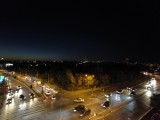



Ultrawide camera, Auto Night Mode OFF
Finally, all cameras support Tripod Night Mode. The 2x and 6x photos are still two times digital zoom over the main and telephoto cameras.
The default ultrawide, 1x and 3x photos shot with the help of the Tripod Night Mode are just marvelous across the board. So, if an occasion arises and you can use this mode, you should try it.
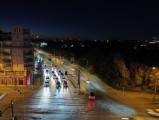
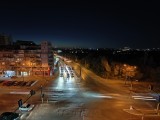



Tripod Night Mode: 1x • 0.6x • 2x • 3x • 6x
And here's how the main camera stacks up against the competition in our extensive Photo compare database.


OnePlus Open against the Galaxy Z Fold5 and the Huawei Mate X3 in our Photo compare tool
Reader comments
- anonpoaster
- 04 Jul 2024
- Dk5
How the hell did Oneplus manage to fumble with the OP12 regarding camera quality? Open takes the best night mode pics I've seen on this site and I'm comparing it directly with a Pro 15 Max with the same scenes!
- Gaia
- 02 Jan 2024
- Y7W
Just came back to say that emulation on Android has hugely improved since I made my comment. Current version of Yuzu emulator runs most Switch games on a Oneplus 10T extremely good. The reason why a computer struggles is due to the computer's ar...
- Ryuhoshi
- 10 Dec 2023
- mME
After looking at the photos of the telephoto camera and comparing it to all of the competitors, including from last year, it seems this is by far the best telephoto camera. Look especially at the night photo from the telephoto camera of the buildin...









































































































































